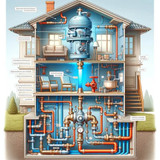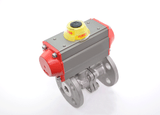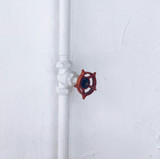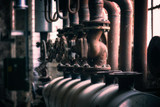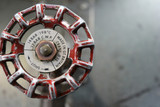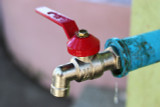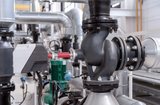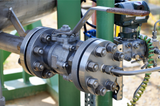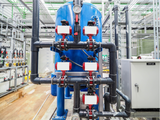Actuated Butterfly Valves

What is an Actuated Butterfly Valve?
An Actuated Butterfly Valve consists of two parts: an actuator and a butterfly valve. An actuator is a mechanism used for closing and opening a valve. The actuator uses air, electricity, or a spring to open and close the valve. The butterfly valve regulates or isolates flow, using a disk as a closing mechanism. Thus--in short--within an actuated butterfly valve, the actuated butterfly valve works by taking supplied energy from the actuator and moves the butterfly valve disc accordingly.
In the center of the pipe is a plate or disc. A rod, connected to the actuator, passes through the disc in the center of the pipe. When the actuator is turned (rotated), the disc will become either parallel or perpendicular to the flow. In an actuated butterfly valve, the disc will slightly open and close to establish or control the media’s flow rate. As the disc on the butterfly valve closes, the upstream pressure will increase, while the downstream pressure will decrease.
The disc can be iron, stainless steel, aluminum/bronze or nickel-plated. Materials for the stem include stainless steel or carbon steel.
The rotary stem of the butterfly valve moves to a maximum of 90 degrees. The design itself is compact; there are no pockets; thus, fluid cannot become trapped. This is the reason that butterfly valves are often used in sanitary applications, although they are not a true sanitary valve per se.
Uses and Advantages
Actuated butterfly valves are very common in the agricultural, water and wastewater treatment industries. Actuated butterfly valves can be used for water, gas, and air-cooling, for vacuum service, and high pressure/temperature water services.
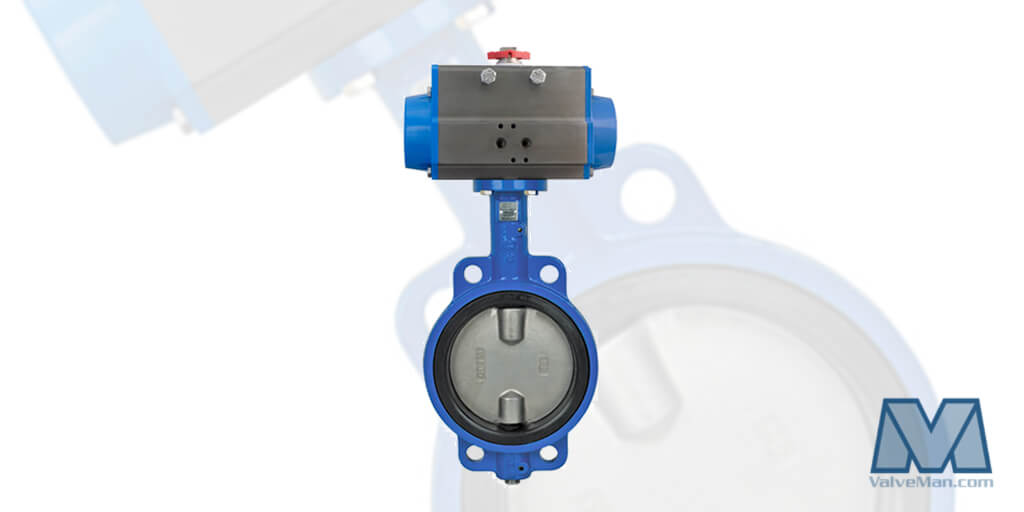
Actuated butterfly valves are often small and are able to be opened and closed quickly. It’s compact, lightweight, and available in wide selection of sizes. In fact, some butterfly valves are so large, an average adult could stand completely upright within its orifice. However, the bigger the valve the larger the actuator is required. And, the size and weight of the valve package is definitely a factor in many applications. Thus, some manufacturers have gone to great lengths to reduces the size of the actuator on large automated valve packages. Vein actuators continue to grow in popularity, because they can significantly reduce the size of the actuator that is operating the valve(NOTE: For more information on vein actuation, visit our Easytork Valves page). Regardless of the actuator needed, butterfly valves have proven themselves to be reliable, precise, and require very little maintenance. If properly specified and maintained, they provide a tight, reliable, two directional shut off.
Slurry buildup can affect a butterfly valve’s performance. In addition, slurry can make the butterfly valve difficult to clean. For this reason, when dealing with extreme applications, it is recommended to use a double or triple offset butterfly valve.
If you found this overview interesting, please consider checking out the following resources offered by our valve store:
Actuated Butterfly Valves - Related Articles
Actuated Butterfly Valves 101: All You Need To Know About Their Application In Piping Systems
Our Posts
View AllTypes of Valves in Plumbing
Have you ever wondered what goes into managing the flow of water in your home, or through a building …
Read MoreIntroducing Apollo Valves
Apollo Valves® inventory includes a wide range of valve products supplied to diverse markets. Th …
Read MoreUnderstanding Valve Sizes and Measurement
Sizing the appropriate valve is critical to ensuring the performance of your system. Whether you'r …
Read MoreTypes of Water Valves
Hey there, fellow valve enthusiasts! We all know that valves play a crucial role in regulating th …
Read MoreWhat is a Backflow Preventer, and How Does it Work?
When a simple check valve is inadequate for the job, you need a backflow preventer. But knowing …
Read MoreValve inspection - main points of valve testing in Manufacture setting
Industrial facilities rely on different types of valves (such as check valves, for example) to con …
Read MoreTypes of Ball Valves
Ball valves are important components in a vast range of systems, from small family-owned workshops …
Read MoreUnderstanding valve standards and specifications
Hey there, fellow valve enthusiasts! Today, we're looking at valve codes, standards and specifica …
Read MoreHow to Tell if a Valve is On or Off
We have all been there before. You are staring at a valve; you know that you should know if it …
Read MoreUnderstanding Different Types of Valve Connections and Fittings
Hey there, fellow valve enthusiasts! We know valves play a crucial role in regulating the flow of li …
Read MoreTypes of Valve Handles: Lever and Handwheels
Whether you're involved in industrial work, plumbing, or you're a DIY enthusiast, you come across va …
Read MoreThe Basic Parts of a Valve
Valves quietly work in many different areas, even places you wouldn't expect. They're truly every …
Read MoreGas Ball Valves In Industrial Applications - 5 Things to Keep in Mind
Unlike the standard ball valves, most gas ball valves are tested and approved by CSA. These valves a …
Read MoreHow To Correctly Use A 3 Way Valve In Different Applications
To understand the "T"-port and an "L"-port 3-way valves and what makes them different, it's importan …
Read MoreIndustrial Ball Valves - 9 Questions To Make The Right Choice
Ball valves are versatile flow control devices suitable for extensive industrial applications. They …
Read MoreEverything you need to know about valve types
Valves play crucial roles in production lines and equipment performance across a multitude of ind …
Read MoreWhat is a Duty Cycle and How Does it Relate to Electric Ball Valves?
Electric actuation improves the efficiency of processes by maintaining the accuracy of the re …
Read MoreActuated Butterfly Valves 101: All You Need To Know About Their Application In Piping Systems
Butterfly valves are quarter-turn flow control or isolation devices, used for quick shut-off in p …
Read MorePractical Guide To Electric and Pneumatic Actuators – Which One To Choose?
While electrical and pneumatic actuators have several unique benefits and are preferred in differ …
Read MoreHow Do Check Valves Affect Water Pressure in the Piping System?
Check valves also known as "one-way" valves are autonomously operated unidirectional valves that all …
Read More



